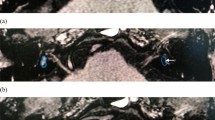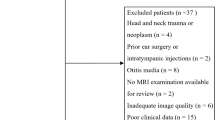Abstract
Purpose
To compare the correlation between different grading methods of vestibular endolymphatic hydrops (EH) and the severity of hearing loss in Ménière’s disease (MD), and evaluate the diagnostic value of these methods in diagnosing MD.
Methods
This retrospective study included 30 patients diagnosed with MD from June 2021 to August 2023. All patients underwent inner ear MR gadolinium-enhanced imaging using three-dimensional (3D)-real inversion recovery sequences and pure-tone audiometry. The EH levels were independently evaluated according to the classification methods outlined by Nakashima et al. (Acta Otolaryngol Suppl 5–8, 2009. https://doi.org/10.1080/00016480902729827) (M1), Fang et al. (J Laryngol Otol 126:454–459, 2012. https://doi.org/10.1017/S0022215112000060) (M2), Barath et al. (Am J Neuroradiol 35:1387–1392, 2014. https://doi.org/10.3174/ajnr.A3856), (M3), Liu et al. (Front Surg 9:874971, 2022. https://doi.org/10.3389/fsurg.2022.874971), (M4), and Bernaerts et al. (Neuroradiology 61:421–429, 2019. https://doi.org/10.1007/s00234-019-02155-7) (M5), with a subsequent comparison of interobserver agreement. After achieving a consensus, an analysis was performed to explore the correlations between vestibular EH grading using different methods, the average hearing thresholds at low-mid, high-, and full frequencies and clinical stages. The diagnostic capabilities of these methods for MD were then compared.
Results
The interobserver consistency of M2–M5 was superior to that of M1. The EH grading based on M4 showed a significant correlation with the average hearing thresholds at low-mid, high-, and full frequencies and clinical stages. M1, M2, M3, and M5 correlated with some parameters. A receiver operating characteristic curve analysis indicated that M5 significantly outperformed M1, M2, M3, and M4 in terms of diagnostic efficiency for MD.
Conclusion
M4 showed the strongest correlation with the degree of hearing loss in patients with MD, whereas M5 showed the highest diagnostic performance.



Similar content being viewed by others
Data availability
The data that support the findings of this study are available on request from the corresponding author.
References
Hoskin JL (2022) Ménière’s disease: new guidelines, subtypes, imaging, and more. Curr Opin Neurol 35:90–97. https://doi.org/10.1097/WCO.0000000000001021
Connor SEJ, Pai I (2021) Endolymphatic hydrops magnetic resonance imaging in Ménière’s disease. Clin Radiol 76:76.e1-76.e19. https://doi.org/10.1016/j.crad.2020.07.021
Zhang W, Hui L, Zhang B, Ren L, Zhu J, Wang F, Li S (2021) The correlation between endolymphatic hydrops and clinical features of Meniere disease. Laryngoscope 131:E144–E150. https://doi.org/10.1002/lary.28576
Han A, Kontorinis G (2023) A systematic review on delayed acquisition of post-gadolinium magnetic resonance imaging in Ménière’s disease: imaging of the endolymphatic spaces. J Laryngol Otol 137:239–245. https://doi.org/10.1017/S0022215122001347
Editorial Board of Chinese Journal of Otorhinolaryngology Head and Neck Surgery, & Society of Otorhinolaryngology Head and Neck Surgery Chinese Medical Association (2017) Guideline of diagnosis and treatment of Meniere disease (2017). Zhonghua Er Bi Yan Hou Tou Jing Wai Ke Za Zhi 52:167–172. https://doi.org/10.3760/cma.j.issn.1673-0860.2017.03.002
Iwasaki S, Shojaku H, Murofushi T, Seo T, Kitahara T, Origasa H, Watanabe Y, Suzuki M, Takeda N (2021) Diagnostic and therapeutic strategies for Meniere’s disease of the Japan Society for Equilibrium Research. Auris Nasus Larynx 48:15–22. https://doi.org/10.1016/j.anl.2020.10.009
Liu Y, Pyykkö I, Naganawa S, Marques P, Gürkov R, Yang J, Duan M (2022) Consensus on MR imaging of endolymphatic hydrops in patients with suspected hydropic ear disease (Meniere). Front Surg 9:874971. https://doi.org/10.3389/fsurg.2022.874971
Editorial Board of Chinese Journal of Otorhinolaryngology Head and Neck Surgery; & Society of Otorhinolaryngology Head and Neck Surgery, Chinese Medical Association (2020) The consensus of Chinese experts on evaluation of EH in the inner ear using MRI. Zhonghua Er Bi Yan Hou Tou Jing Wai Ke Za Zhi 55:809–813. https://doi.org/10.3760/cma.j.cn115330-20200327-00248
Deng W, Lin X, Su Y, Cai Y, Zhong J, Ou Y (2022) Comparison between 3D-FLAIR and 3D-real IR MRI sequences with visual classification method in the imaging of endolymphatic hydrops in Meniere’s disease. Am J Otolaryngol 43:103557. https://doi.org/10.1016/j.amjoto.2022.103557
Baráth K, Schuknecht B, Naldi AM, Schrepfer T, Bockisch CJ, Hegemann SC (2014) Detection and grading of endolymphatic hydrops in Menière disease using MR imaging. AJNR Am J Neuroradiol 35:1387–1392. https://doi.org/10.3174/ajnr.A3856
Han Z, Qiu X, Huang Y, Sun Q, Ding H, Xie J, Guo J, Yang Y, Liu Y, Gong S, Zhao P, Wang Z (2023) Correlation between grading methods of the cochlear endolymphatic hydrops and hearing loss in Meniere’s disease using three-dimensional real inversion recovery sequences. Acta Otolaryngol 143:370–375. https://doi.org/10.1080/00016489.2023.2209134
Nakashima T, Naganawa S, Pyykko I, Gibson WP, Sone M, Nakata S, Teranishi M (2009) Grading of endolymphatic hydrops using magnetic resonance imaging. Acta Otolaryngol. https://doi.org/10.1080/00016480902729827
Gürkov R, Flatz W, Louza J, Strupp M, Krause E (2011) In vivo visualization of endolyphatic hydrops in patients with Meniere’s disease: correlation with audiovestibular function. Eur Arch Otorhinolaryngol 268:1743–1748. https://doi.org/10.1007/s00405-011-1573-3
Yang S, Zhu H, Zhu B, Wang H, Chen Z, Wu Y, Chen B, Shi H, Li Y, Zou J, Yin S (2018) Correlations between the degree of endolymphatic hydrops and symptoms and audiological test results in patients with Menière’s disease: a reevaluation. Otol Neurotol 39:351–356. https://doi.org/10.1097/MAO.0000000000001675
Fang ZM, Chen X, Gu X, Liu Y, Zhang R, Cao DR, He HG (2012) A new magnetic resonance imaging scoring system for perilymphatic space appearance after intratympanic gadolinium injection, and its clinical application. J Laryngol Otol 126:454–459. https://doi.org/10.1017/S0022215112000060
Liu F, Huang W, Chen Q, Gao Z (2015) Comparison of noninvasive evaluation of endolymphatic space in healthy volunteers in different age groups using magnetic resonance imaging. Acta Otolaryngol 135:416–421. https://doi.org/10.3109/00016489.2014.986760
Bernaerts A, Vanspauwen R, Blaivie C, van Dinther J, Zarowski A, Wuyts FL, Vanden Bossche S, Offeciers E, Casselman JW, De Foer B (2019) The value of four stage vestibular hydrops grading and asymmetric perilymphatic enhancement in the diagnosis of Menière’s disease on MRI. Neuroradiology 61:421–429. https://doi.org/10.1007/s00234-019-02155-7
Lopez-Escamez JA, Carey J, Chung WH, Goebel JA, Magnusson M, Mandalà M, Newman-Toker DE, Strupp M, Suzuki M, Trabalzini F, Bisdorff A (2015) Diagnostic criteria for Menière’s disease. J Vestib Res 25:1–7. https://doi.org/10.3233/VES-150549
Yang CJ, Yoshida T, Sugimoto S, Teranishi M, Kobayashi M, Nishio N, Naganawa S, Sone M (2021) Lesion-specific prognosis by magnetic resonance imaging in sudden sensorineural hearing loss. Acta Otolaryngol 141:5–9. https://doi.org/10.1080/00016489.2020.1827159
Niu Y, Chen W, Lin M, Sha Y (2022) Development and characteristics of hearing loss with the progression of endolymphatic hydrops. Ear Nose Throat J. https://doi.org/10.1177/01455613221101088
Sun Q, Jiang G, Xiong G, Sun W, Wen W, Wei F (2021) Quantification of endolymphatic hydrops and its correlation with Meniere’s disease clinical features. Clin Otolaryngol 46:1354–1361. https://doi.org/10.1111/coa.13847
Committee on Hearing and Equilibrium guidelines for the diagnosis and evaluation of therapy in Menière’s disease (1995) American Academy of Otolaryngology-Head and Neck Foundation, Inc. Otolaryngol Head Neck Surg 113:181–185. https://doi.org/10.1016/S0194-5998(95)70102-8
Liu F, Huang W, Meng X, Wang Z, Liu X, Chen Q (2012) Comparison of noninvasive evaluation of endolymphatic hydrops in Meniere’s disease and endolymphatic space in healthy volunteers using magnetic resonance imaging. Acta Otolaryngol 132:234–240. https://doi.org/10.3109/00016489.2011.637232
Sone M, Yoshida T, Sugimoto S, Kobayashi M, Teranishi M, Naganawa S (2022) Pathological significance and classification of endolymphatic hydrops in otological disorders. Nagoya J Med Sci 84:497–505. https://doi.org/10.18999/nagjms.84.3.497
Han SC, Kim YS, Kim Y, Lee SY, Song JJ, Choi BY, Kim JS, Bae YJ, Koo JW (2022) Correlation of clinical parameters with endolymphatic hydrops on MRI in Meniere’s disease. Front Neurol 13:937703. https://doi.org/10.3389/fneur.2022.937703
Wnuk E, Lachowska M, Jasińska-Nowacka A, Maj E, Rowiński O, Niemczyk K (2022) Detailed insight into magnetic resonance assessment of Ménière’s disease—description of methodology and imaging findings in a case series. Pol J Radiol 87:e354–e362. https://doi.org/10.5114/pjr.2022.117971
Jasińska A, Lachowska M, Wnuk E, Pierchała K, Rowiński O, Niemczyk K (2022) Correlation between magnetic resonance imaging classification of endolymphatic hydrops and clinical manifestations and audiovestibular test results in patients with definite Ménière’s disease. Auris Nasus Larynx 49:34–45. https://doi.org/10.1016/j.anl.2021.03.027
Acknowledgements
None.
Funding
This study was supported by the National Natural Science Foundation of China (No.61931013, No. 82171886) the Natural Science Foundation of Beijing Municipality (No.7222301), the Beijing Scholars Program (No. [2015] 160), and the Beijing key Clinical Discipline Funding (No. 2021-135).
Author information
Authors and Affiliations
Contributions
Conceptualization: ZH, YH, PZ. Methodology: ZH, YH, YL, SG, ZY. Data curation: ZH, YH. Writing—original draft preparation: ZH, YH. Writing—review and editing: all authors. Visualization: JX, ZW, PZ. Supervision: PZ. All authors contributed to the article and approved the submitted version.
Corresponding author
Ethics declarations
Ethics approval
This study adhered to the Declaration of Helsinki and ethical approval was obtained from the Ethics Committee of Beijing Friendship Hospital, Capital Medical University (No. 2022-P2-259-02). Informed consent was obtained from all patients.
Competing interests
The authors declare that there are no competing interests to report.
Additional information
Publisher's Note
Springer Nature remains neutral with regard to jurisdictional claims in published maps and institutional affiliations.
Rights and permissions
Springer Nature or its licensor (e.g. a society or other partner) holds exclusive rights to this article under a publishing agreement with the author(s) or other rightsholder(s); author self-archiving of the accepted manuscript version of this article is solely governed by the terms of such publishing agreement and applicable law.
About this article
Cite this article
Han, Z., Huang, Y., Xie, J. et al. Comparative analysis of vestibular endolymphatic hydrops grading methods and hearing loss in Ménière’s disease: a retrospective MRI study using 3D-real inversion recovery sequence. Eur Arch Otorhinolaryngol (2024). https://doi.org/10.1007/s00405-024-08630-z
Received:
Accepted:
Published:
DOI: https://doi.org/10.1007/s00405-024-08630-z




